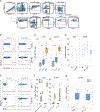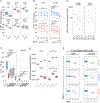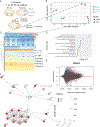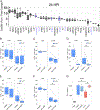Differential Induction of IFN-α and Modulation of CD112 and CD54 Expression Govern the Magnitude of NK Cell IFN-γ Response to Influenza A Viruses
- PMID: 30143589
- PMCID: PMC6143432
- DOI: 10.4049/jimmunol.1800161
Differential Induction of IFN-α and Modulation of CD112 and CD54 Expression Govern the Magnitude of NK Cell IFN-γ Response to Influenza A Viruses
Abstract
In human and murine studies, IFN-γ is a critical mediator immunity to influenza. IFN-γ production is critical for viral clearance and the development of adaptive immune responses, yet excessive production of IFN-γ and other cytokines as part of a cytokine storm is associated with poor outcomes of influenza infection in humans. As NK cells are the main population of lung innate immune cells capable of producing IFN-γ early in infection, we set out to identify the drivers of the human NK cell IFN-γ response to influenza A viruses. We found that influenza triggers NK cells to secrete IFN-γ in the absence of T cells and in a manner dependent upon signaling from both cytokines and receptor-ligand interactions. Further, we discovered that the pandemic A/California/07/2009 (H1N1) strain elicits a seven-fold greater IFN-γ response than other strains tested, including a seasonal A/Victoria/361/2011 (H3N2) strain. These differential responses were independent of memory NK cells. Instead, we discovered that the A/Victoria/361/2011 influenza strain suppresses the NK cell IFN-γ response by downregulating NK-activating ligands CD112 and CD54 and by repressing the type I IFN response in a viral replication-dependent manner. In contrast, the A/California/07/2009 strain fails to repress the type I IFN response or to downregulate CD54 and CD112 to the same extent, which leads to the enhanced NK cell IFN-γ response. Our results indicate that influenza implements a strain-specific mechanism governing NK cell production of IFN-γ and identifies a previously unrecognized influenza innate immune evasion strategy.
Copyright © 2018 by The American Association of Immunologists, Inc.
Conflict of interest statement
The authors have declared that no conflict of interest exists.
Figures








Similar articles
-
Type I interferon plays opposing roles in cytotoxicity and interferon-γ production by natural killer and CD8 T cells after influenza A virus infection in mice.J Innate Immun. 2014;6(4):456-66. doi: 10.1159/000356824. Epub 2014 Jan 10. J Innate Immun. 2014. PMID: 24435166 Free PMC article.
-
Phenotypic and Functional Characteristics of a Novel Influenza Virus Hemagglutinin-Specific Memory NK Cell.J Virol. 2021 May 24;95(12):e00165-21. doi: 10.1128/JVI.00165-21. Print 2021 May 24. J Virol. 2021. PMID: 33827945 Free PMC article.
-
Respiratory Influenza A Virus Infection Triggers Local and Systemic Natural Killer Cell Activation via Toll-Like Receptor 7.Front Immunol. 2018 Feb 13;9:245. doi: 10.3389/fimmu.2018.00245. eCollection 2018. Front Immunol. 2018. PMID: 29497422 Free PMC article.
-
Elevated frequency of gamma interferon-producing NK cells in healthy adults vaccinated against influenza virus.Clin Vaccine Immunol. 2008 Jan;15(1):120-30. doi: 10.1128/CVI.00357-07. Epub 2007 Nov 14. Clin Vaccine Immunol. 2008. PMID: 18003818 Free PMC article.
-
The Mechanism behind Influenza Virus Cytokine Storm.Viruses. 2021 Jul 14;13(7):1362. doi: 10.3390/v13071362. Viruses. 2021. PMID: 34372568 Free PMC article. Review.
Cited by
-
CytoGLMM: conditional differential analysis for flow and mass cytometry experiments.BMC Bioinformatics. 2021 Mar 22;22(1):137. doi: 10.1186/s12859-021-04067-x. BMC Bioinformatics. 2021. PMID: 33752595 Free PMC article.
-
Minimizing Batch Effects in Mass Cytometry Data.Front Immunol. 2019 Oct 15;10:2367. doi: 10.3389/fimmu.2019.02367. eCollection 2019. Front Immunol. 2019. PMID: 31681275 Free PMC article. Review.
-
Mass Cytometry Analysis of the NK Cell Receptor-Ligand Repertoire Reveals Unique Differences between Dengue-Infected Children and Adults.Immunohorizons. 2020 Oct 16;4(10):634-647. doi: 10.4049/immunohorizons.2000074. Immunohorizons. 2020. PMID: 33067399 Free PMC article.
-
Dendritic cell-natural killer cell cross-talk modulates T cell activation in response to influenza A viral infection.Front Immunol. 2022 Dec 22;13:1006998. doi: 10.3389/fimmu.2022.1006998. eCollection 2022. Front Immunol. 2022. PMID: 36618376 Free PMC article.
-
Ebola virus protein VP40 stimulates IL-12- and IL-18-dependent activation of human natural killer cells.JCI Insight. 2022 Aug 22;7(16):e158902. doi: 10.1172/jci.insight.158902. JCI Insight. 2022. PMID: 35862204 Free PMC article.
References
-
- Ge MQ, Ho AWS, Tang Y, Wong KHS, Chua BYL, Gasser S, and Kemeny DM. 2012. NK cells regulate CD8+ T cell priming and dendritic cell migration during influenza A infection by IFN-γ and perforin-dependent mechanisms. J. Immunol 189: 2099–2109. - PubMed
-
- Stein-Streilein J, Bennett M, Mann D, and Kumar V. 1983. Natural killer cells in mouse lung: surface phenotype, target preference, and response to local influenza virus infection. J. Immunol 131: 2699–2704. - PubMed
Publication types
MeSH terms
Substances
Grants and funding
LinkOut - more resources
Full Text Sources
Other Literature Sources
Medical
Research Materials

